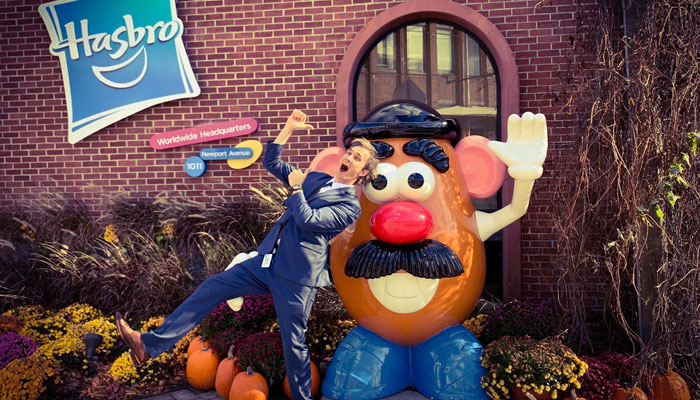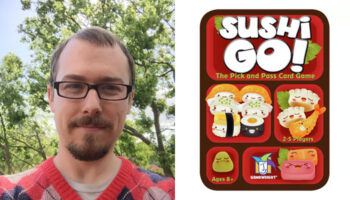Hasbro’s Gray Bright on bringing Wordle into board games

Gray, it’s always great to catch up. Before we dive into Wordle: The Party Game, at what point did you become aware that this daily online puzzle was taking the world by storm?
We became interested in Wordle in the same way as many around the world did – we were players! Many people on our team and throughout Hasbro were playing Wordle every day. Our friends were playing it, our families were playing it… Everyone was playing it! When a game has that many people playing organically, there’s something special in the air. Wordle’s attention in the media was growing and amplifing day by day, and the social power of people sharing their results made it truly viral.
Billy, I actually remember back to January of this year, you sent an email out to the community asking if we felt Wordle’s success might have an impact on the board game space – so you recognised the power of it!
Well remembered! Yes, that was a fun piece to put together.
Yes; further proof that it had really entered the zeitgeist.
And its power hasn’t waned! I still play it everyday – and I confess, I’m a midnight Wordler.
You play just after midnight to get the fresh Wordle?
I do! It’s an addiction! Now, earlier this year Hasbro launched Wordle: The Party Game. What made this puzzle ripe for a board game adaptation?
Since Josh Wardle released Wordle into the public in October 2021, it’s become a phenomenon that’s now woven into the cultural conversation… Wordle is now part of everyday vocabulary! The fact you’re playing at midnight proves this game is important to people.
After seeing the social conversations going on, we saw an opportunity to extend Wordle in new ways. Players wanted to connect and experience fun, exciting Wordle moments in real life. That’s what Wordle: The Party Game is.

On paper, the biggest challenge with translating Wordle into a board game is that it’s a solo experience, and the site does a lot of the heavy lifting in terms of choosing the word for that day and telling you how close your guess is. How did you overcome those Wordle hurdles?
Yes, the experience of Wordle online is solitary but the experience of sharing your score is social. The ability for players to play against each other and instantly share their scores needed to be a throughline for our physical version.
We then began having conversations about what would make for the best user experience. We had many people in our business thinking about how Wordle could translate from digital to physical, from our playmakers to our designers. Through our partnership with The New York Times, we created so many variations during the development process…
We tested head-to-head games where each player takes a guess and corrects their opponents scorepad. We prototyped electronic versions and processed so many games through our iterative test and learn loops. All the while, getting as many people around the table has been core to our vision.
You actually mentioned the toughest nut to crack: the computer does a lot of the heavy lifting. We had to design a game mechanic to offload that task in a way that was fun and didn’t feel like work. Our north star was always the digital app; the play had to feel inherently similar to how you play online. That was key.

Talk us through that. How did you go about translating the digital grid into something that works in real life?
That was a key focus. We had to keep the green and yellow tiles, but there’s no simple way to automate that with plastic and cardboard while retaining the visual likeness of the app. We arrived early on what an expression of the physical board could be. In essence, it’s a screenshot of the app. We started with low fidelity playable prototypes and continually playtested and enhanced this via our feedback loops.
I’m an avid reader of Mojo Nation, and I wanted to mention some tools we used, in case that’s of interest to any inventors reading. Our initial prototypes were made with found objects like blank pieces of cardboard and Scrabble tiles – and that’s not a cross-promotion; we really did use them for prototypes!

I believe you! You mentioned that getting as many people around the table was important to this design process…
Yes! To give you an idea, these are the names I interacted with – so this doesn’t include people from the wider business that got involved – Joe, Megan, Anthony, Jillian, Sammy, Chris, Dan, Cam, Phil, Tanya, Danielle, Christina, Sophie, Krishna, Brian, Julian, Baker, Jeff, Casey, Eric, Tracey…
Breathe Gray!
Ha! And then there’s the guys at The New York Times: Mark, Jessica, Ed… When you start to realise the amount of people that touched this game, it’s incredible. The game really had an impact on lots of people at Hasbro.
We’ve discussed that a key part of Wordle’s success has been in the sharing of scores through those coloured grids. Did that sharing side of the game influence any part of how you put together Wordle: The Party Game?
Yes. It was the primary reason for including the reusable scoreboard. It allows for scoring during the game, but it was designed so that you can easily take a photo of it and share that online or to keep in your photo album as a record of the victory.
I’d imagine most games that Hasbro launches have one key way to play. Alongside the core way to play Wordle: The Party Game, it also comes with three extra modes: fast, timed or teams. Why include these variations?
Our goal in creating an analogue version of Wordle was to serve the Wordle purist, while looking for relatable ways to play with friends and family. When you translate a digital game into a physical game, there are things that make sense to keep and there are fresh things that are unlocked when you start playing around a table. We found new play patterns emerged almost through house rules. People had a natural tendency to play in certain ways, like playing in a team or finding ways to speed up the game.
We paired these playtesting observations with some higher level mechanics and objectives we had set for ourselves. We were able to then craft multiple versions that allow Wordle to be played in new ways and ultimately add extra value to the product.

And Gray, presuming you’re not sick to the back teeth of Wordle by now, do you have a go-to first word that you always use when playing the game?
Yes! I use the same word every day! I use ‘PARTY’. It’s been an important word throughout this entire development process, and I use it both in the digital game and when playing Wordle: The Party Game.
Good to know should we ever play the game together!
It’s funny, a bunch of people on our team also have one word they use to start Wordle every day. Some of the words I know people use are ‘ADIEU’, ‘AUDIO’, ‘SLATE’, ‘CRANE’, ‘SLANT’, ‘CRATE’, ‘SLICE’, ‘TRIED’, ‘CLOSE’, ‘TWICE’, ‘TRANCE’, ‘TRAIN’… That’s the melting pot of popular first Wordle words at Hasbro!
I tend to go for ‘DREAM’ but ‘ADIEU’ is a corker! I’m having that. Gray, this has been fun. Before I let you go, are there any other recent Hasbro launches you want to flag that we should keep an eye on?
Yes, we are ultra-excited about our new Clue Escape range. The first in our escape & solve mystery game series, Clue Escape – Treachery at Tudor Mansion recently launched and is winning awards – plus receiving incredibly good reviews.

We also have Clue Escape – Sabotage on the High Seas and Clue Escape – Robbery at the Museum launching now. I highly recommend playing these escape games, they are so fun and bring Clue to life in a whole new way!
Gray, a huge thanks again. Let’s catch up again soon!
–
To stay in the loop with the latest news, interviews and features from the world of toy and game design, sign up to our weekly newsletter here






















